A-10A
JAWS Schemes
Part
One
by
Dana Bell
|
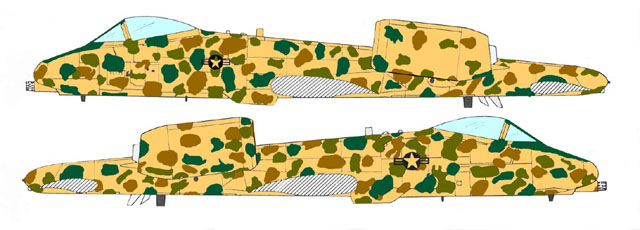
|
|
A-10A in
JAWS Scheme
Fuselage "Spotted" Pattern for A-10A 75-262 |
Dateline 1978. I was busily applying ink and Zip-a-tone to a series
of A-10 drawings for special 12-page edition of Pri-Fly, the IPMS
Washington, DC, chapter publication. Our goal was to portray all of the
color schemes carried by the Warthog. Both the Air Force and Fairchild
Republic were offering a great deal of help, and the drawings were
almost completed. Then, photos began to surface showing an odd splotchy
camouflage being applied at Nellis AFB, Nevada.
A-10A
JAWS "Spotted Camouflage"
|
Jaws, both the book and movie, was still quite popular, and
the military found an excuse to turn the name into an acronym. Tactical
tests of the A-10 and Army attack and observation helicopters became the
"Joint Attack Weapons System."
During the tests, Air Force Aggressor pilots reported that the A-10's
light celestial camouflage scheme made the Warthog easily visible from
above. At Nellis, the 57th Tactical Training Wing assumed the
responsibility for developing terrestrial camouflage schemes. Four
aircraft were given an overall coat of tan, green, or gray, then sprayed
and brushed with spots of three or four other earth tones. Two of the
camouflages were evaluated at JAWS II in November 1977. The scheme's
developers had plans for repaint kits to accompany deploying units,
changing the spots on aircraft as geographical conditions required (much
like the Army's temporary camouflages of the 1930s), but by September
1978 Nellis was developing what became the European I (or Lizard)
scheme, and the spotted camouflages became a minor, though
well-remembered, camouflage oddity. (Note that several special
operations H-1s and H-3s carried a similar camouflage called the Leopard
scheme; these spots were applied to represent aggressors in helicopter
versus helicopter evaluations, and were not used for operational
purposes.)
The Air Force was able to supply nearly two hundred detail slides and
prints of the aircraft, enough that I felt I could fully reproduce the
schemes on two of the aircraft. Detail documentation was incomplete for
a third aircraft, and the fourth was no longer available. We expanded
the monograph to sixteen pages to fit in the new drawings, and published
in August 1978. The drawings were republished several times, including
Microscale sheet 48-69. In trying to scan them for this article,
however, I couldn't get comfortable with the resolution, so I spent a
couple of afternoons "coloring them in" with photo shop. The
drawings are only schematics, but we're including several of the better
photos to help any modeler who wishes to try to get all the spots in the
actual locations!
Only five colors were used initially, though a couple of others were
used for later touch-ups. One aircraft (75-259) used all five colors;
the two tan aircraft (75-258 and 75-262) did not use the gray, and the
gray aircraft (75-260) did not use the tan. The colors were: gray 36213,
dark green 34092, olive green 34102, brown 30118, and tan 30227.
A-10A
JAWS Characteristics
|
Modelers should note that early A-10s displayed a number of detail
differences. These will be particularly important for any of the newer
kits, such as the 1/32d scale Trumpeter model, but several of the older
kits can be built as the early production aircraft will no
modifications.
The USAF had originally planned for ten pre-production aircraft, all
to be built at Farmingdale, NY. Congress cut the funding to six
pre-production airframes after work had begun on ten, so the last four
pre-production aircraft simply became the first four production
aircraft. Three of those four aircraft wore the JAWS camouflages. The
effects on modelers are minor: for aircraft 75-258 through 75-261, the
flaps could deploy 30 degrees, and the flap guides extended several
inches beyond the wings' trailing edges. For aircraft 75-262 and all
subsequent A-10s, the flaps deployed only 20 degrees, and the flap
guides were flush with the wings' trailing edges. None of the
JAWS-scheme aircraft were delivered with the dorsal formation/flood
light, though both 75-259 and 75-262 had one fitted to by the time they
received the spotted camouflages.
The following details applied to all four of the JAWS-camouflaged
aircraft:
-
The ESCAPAC 1E-9 ejection seat was
fitted
-
The original square boarding ladder was
fitted
-
Each had an X-band radar antenna
mounted atop the right vertical fin
-
Each had the underside UHF/TACAN
antenna mounted forward, next to the nose gear door
-
All had the old box-style antenna under
the nose (to the right of the gun) and under the tail
-
None had the ALR-69 radar warning lumps
on the nose or tail (there are four each on current A-10s)
-
None had nose-illuminating flood lights
inside of racks 1 and 11
-
None had the INS intake or exhaust to
the right side of the canopy
-
None had ammo loading door cover
scoops
-
None had chaff/flare dispensers under
the wingtips or on the wheel sponsons.
The next article will include photos of 75-258 and 75-260, and the
last article will have drawings and photos of 75-259. This article will
concentrate on 75-262, the first production aircraft delivered from
Fairchild's Hagerstown, Maryland, facility. Accepted on 31 March 1976,
262 reported initially to the 355th Tactical Fighter Wing at Davis-Monthan
AFB, Arizona.
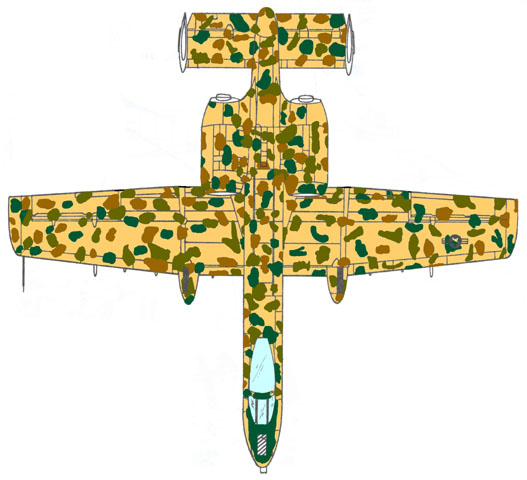 |
|
Upper
Surface "Spotted" Pattern for A-10A 75-262 |
There is some controversy over its original, delivery camouflage. Air
Force records show that the aircraft was evaluated in 36320 Dark Ghost
Gray undersurfaces, with special 40% reflecting MASK-10A paint on
uppersurfaces and sides. (The unusual MASK-10A paints had no FS595
equivalents, and changed colors under different lighting conditions.)
Fairchild factory drawings agree about the Dark Ghost Gray, but claim
that a lighter 50% reflecting MASK-10A was applied to uppers and sides.
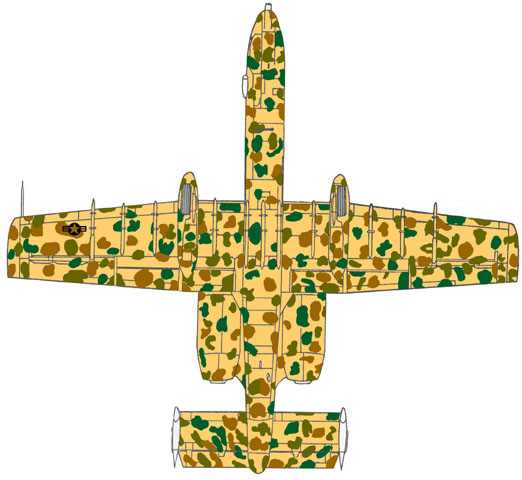 |
|
Lower
Surface "Spotted" Pattern for A-10A 75-262 |
After moving to Nellis, 262 became one of the two spotted A-10s to
participate in November 1977's JAWS II exercises. It also flew out of
British and German bases in early 1978 during European evaluations and
tests of the Imaging Infrared (IIR) AGM-65D Maverick missile.
|
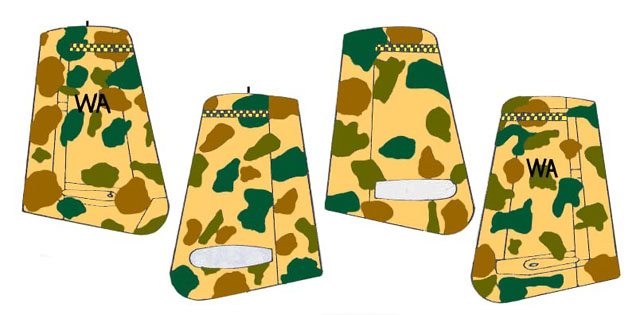
|
|
Vertical
Tails "Spotted" Pattern for A-10A 75-262 |
The aircraft's spotted camouflage included a base coat of tan 30227,
with spots of dark green 34092, olive green 34102, and brown 30118. Two
rows of nineteen black and yellow checks were painted atop the inside
and outside fin surfaces, and a low-vis black wing insignia was
stenciled on either side of the fuselage above the national insignia.
|
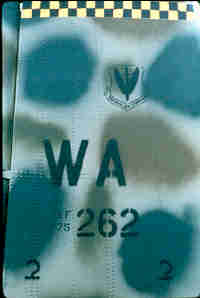
|
The right fin shows
the low-vis TAC shield above the 57th's "WA" tail codes |
|
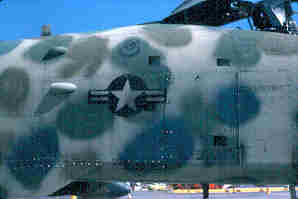
|
The right side of
the forward fuselage shows the 57th shield above the national
insignia. On later aircraft, the INS air intake would be fitted
above, and slightly forward of, the unit insignia. An exhaust
would appear aft, just above the other two exhaust ports. |
|
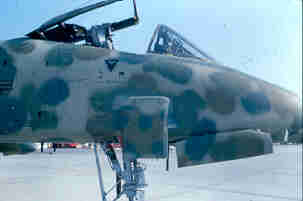
|
The mount for the
Pave Penny pod was attached for this photo. Note the small radar
warning antenna mounted forward of the open nose gear door. |
|

|
The left side of
the nose shows the original square boarding ladder, the flat-faced
ammo loading door, the black knife-blade antenna beside the nose
wheel well, and the top of the old ESCAPAC ejection seat. |
Click the thumbnails below
to view the larger images.
Use your browser's "Back" arrow to return to this page.
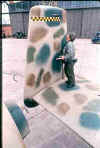








Artwork and Text Copyright © 2001 by Dana Bell
Photographs Copyright © United States Air Force
Page Created 07 May, 2001
Last updated 04 June, 2001
Back to HyperScale
Main Page
Back to Reviews
Page
|
Home |
What's New |
Features |
Gallery |
Reviews |
Reference |
Forum |
Search